Intermarkets' Privacy Policy
Donate to Ace of Spades HQ!
aceofspadeshq at gee mail.com
Buck:
buck.throckmorton at protonmail.com
CBD:
cbd at cutjibnewsletter.com
joe mannix:
mannix2024 at proton.me
MisHum:
petmorons at gee mail.com
J.J. Sefton:
sefton at cutjibnewsletter.com
After Night of Riots and Attacks on Federal Agents, Trump Threatens to Declare Minnesota to be in a State of Insurrection
The Morning Rant: This Is What We Voted For!
Mid-Morning Art Thread
The Morning Report — 1/15/26
Daily Tech News 15 January 2026
Wednesday Overnight Open Thread - January 14, 2026 [TRex]
Rhino Field Goal Cafe
Quick Hits
Trump Stops the Issuance of Visas to Migrants from 75 Welfare-Sucking Countries
Jim Sunk New Dawn 2025
Jewells45 2025
Bandersnatch 2024
GnuBreed 2024
Captain Hate 2023
moon_over_vermont 2023
westminsterdogshow 2023
Ann Wilson(Empire1) 2022
Dave In Texas 2022
Jesse in D.C. 2022
OregonMuse 2022
redc1c4 2021
Tami 2021
Chavez the Hugo 2020
Ibguy 2020
Rickl 2019
Joffen 2014
maildrop62 at proton dot me
TBD
Saturday Gardening Thread: April Showers Bring Mayflowers [Y-not, KT, Weirddave and a Special Guest]
Good afternoon, Gardening Morons!
April showers bring May flowers... but what do Mayflowers bring?

During the Mayflower's voyage, the Pilgrims' main diet would have consisted primarily of a cracker-like biscuit ("hard tack"), salt pork, dried meats including cow tongue, various pickled foods, oatmeal and other cereal grains, and fish. The primary beverage for everyone, including children, was beer. The Pilgrims believed (and rightly so) that water was often contaminated and made people sick; the distillation process killed most parasites and bacteria. Wine may also have been drunk, as was aqua-vitae--a more potent alcohol. The occasional juice from a lemon was also taken to prevent scurvy.Once the Pilgrims had settled themselves in Plymouth, they slowly began to learn about other food sources. The bay was full of fish, although the Pilgrims had poorly equipped themselves for fishing. There were clams, mussels, and other shellfish that could be gathered, and the bay was also full of lobster. Waterfowl such as ducks and geese were hunted, as were wild turkeys and other birds, and even the occasional deer. The Pilgrims had also brought seeds with them to plant English vegetable and herb gardens, as well as larger crops such as barley, peas, and wheat. And while exploring Cape Cod, they discovered and "borrowed" large baskets full of Indian corn they had found buried in the ground on a hill they named Corn Hill. The Native Americans in the area buried their corn seed in large baskets to preserve it for the next year's planting season.
More about the Pilgrims' gardening habits:
Along with Indian corn, the Pilgrims also grew some beans, pumpkins, wheat, barley, oats and peas in their fields. In the gardens near their houses, women grew many different kinds of herbs and vegetables, like parsley, lettuce, spinach, carrots and turnips.
No information available about how they did all that gardening wearing high heels and fishnet stockings.
Y-not's Garden Report
I'll keep my section short because this week we have a Guest Blogger, The Dude.
Spring has really arrived here at the vast and glorious Casa Y-not Estates. We hit 85 yesterday -- zowie! We had a dry winter, so I'm bracing myself for a long, hot summer. (A town up the road from me has already instituted water restrictions.)
I thought I'd highlight two very low maintenance but very high impact plants that we have in our garden for those of you who are looking for something new to plant in your yards.

A couple of years ago we planted four clematis vines. The first year they had a few flowers, but each year they've gotten both bigger in terms of their greenery and produced more blooms. If you've never had clematis before (sounds like a skin disease, doesn't it?) you might be alarmed that first winter when they appear to completely die off. Don't panic! They come back bigger the following year.
One thing I love about them is that they apparently are quite tolerant of shade. I've seen them in full sun, but ours are in shade under the aspens a big part of the day.
And they grow really quickly. I tried to find some scientific measurement of their growth rate, or at least a cool time-lapse video of the vines growing in the Spring, but I failed. But I did find this link to the fastest-growing plants.
Now I've done nothing to them except water them. That's my kind of plant -- stick it in the ground and forget about it! Apparently pruning is recommended. I've gotten away without pruning thus far, but perhaps I should start trimming them back in the Fall.
The other plant that we put in a couple of years ago that has really impressed this self-described lazy gardener is Scotch Broom.
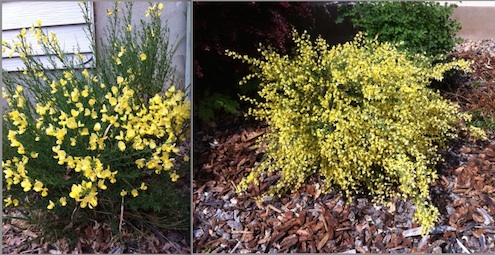
We planted two in our terrible clay soil. Both get a fair amount of sun. The larger one probably gets less sun, primarily in the morning... but it also gets more water, so that may be why it's more vigorous.
Fair warning: this is considered an invasive species. Some states have banned Scotch Broom. Pruning is recommended, although thus far we have not had to do that.
Again, it's a very pretty, drought tolerant, low maintenance, flowering shrub that has year-round interest owing to its interesting foliage. Added bonus: Scotch Broom is evergreen in our neck of the woods.
Now, as promised, here's The Dude (aka "@WoodWhisperers" on Twitter... and host of the Gaming Thread) with some HOT STUFF about peppers:
I love hot chilies. And no, I'm not talking about the simple habanero (which is great as japeleno popper) but stuff in the 1.2m-2.2m scoville range. Me and my friends have always had habanero and scotch bonnet plants but one year a friend of mine bought a ghost pepper plant. After that, the arms race had begun. Because the Bhut Jolokia (ghost pepper) frankly takes like crap (tastes like smoked dirt), we quickly jumped onto the Trinidad named varieties: Trinidad Moruga Scorpion and the Tinidad Scorpion Butch T which both carry a nice floral taste with a hint of cilantro.
Haven't planted my chilies yet this year (hoping this weekend) but the personal stash of chilies plants that I think everyone should have consist of three plants:

Bird's Eye Chili (100,000 - 250,000 SHU) - If you like cooking with chilies, these should be a staple as they are neutral enough that can either be hidden in a dish if you just want heat or they can be boiled a bit in any sauce and they will compliment it. If you like making your own salsa, this works well as a nice change of pace. As long as you keep cutting the the peppers off the stem, this plant is very prolific for as long as the weather holds out. For growing, I personally just stick it in a 12" container with full/partial sun with a watering every day. It's one of the easiest plants you can grow and if you give it full sun, it can make for a nice house plant.

Habanero (100,000 - 350,000 SHU) - It's a classic for a reason. It's has great mix of orange with almost chamomile undertones. Decent spice if ripe but the green ones are also worth cooking with at the end of a season. Throw it in a stone bowl with some garlic & salt and you have one great meat rub for the weekend. Personally, me and my friends love stuffing them with cream cheese and battering them for poppers. You can grow them in a container but they grow a bit better in the ground with a fence/cage. For watering them, you can get away with 2 times a week but for a production/heat trade off, every other day will do you good. Wildlife do tend to like these things in my experience though, namely rabbits and squirrels.

Carolina Reaper (1.2m SHU - 2.2m SHU) - The current world record holder. If you want heat this will give you heat. The fruit has a very nice mix of orange with hints of cocoa and a very nice flowery after taste (me and my friends have never been able to place what kind). Not going to lie, this is more showoff than anything due to the heat so you're kinda limited to what you can use it for.
BEFORE I GET INTO USES, DOUBLE BAG YOU HANDS WITH LATEX GLOVES. WHEN CUTTING THE PEPPERS, THEY WILL GO THROUGH A SINGLE PAIR OF GLOVES AND BURN YOUR SKIN WHICH IS VERY PAINFUL. AND WASH YOUR HANDS WITH DISH SOAP AND SUGAR AS IT WILL BURN YOUR BALLS & PECKER FOR A WEEK (FIRST HAND EXPERIENCE). GLASSES WON'T HURT EITHER
Unless you're looking to be mean, a single pod per 5 pounds of chili about the right mixture. Dry them out in your oven and grind them up (for the love that is all holy, wear respirator if you have one or goggles at the very least) wish a few more fixings for a good little chili powder. Also, they're also well complemented in homemade salsa as long as you go light on it. Is there some horrible mistakes you can make with it? Oh yeah but as long as you're paying attention, it's a great pepper to have in your garden. Hell, if nothing else, it keeps wildlife way from other veggies. As for growing it, you can either keep it in a 14" pot (with a little trimming) or in the ground where it will grow like wildfire (it will hit your roof line if you let it). For watering, unlike most non-super hots, you really have to make up your mind on if you want a lot of pods or if you want it as hot as your weather will allow. You can keep the soil basically at a moist level and it will grow. Sure, the plant will look pathetic and you may only get a 10 pods a month but it will do okay. Water it 2-3 times a week and though the heat will drop (and at this range, the drop is significant) you will get quite a bit of production (the picture up top is one of my harvests from a single plant last year). Other than some aphids and the occasional green caterpillar, there isn't much to worry about as it's a really hardy plant.
Thanks, The Dude! Now here's KT:
Veggie Garden Update
It has been in the 90s this week. The end-of-season sales for veggie plants have been underway. I think it is too late for more tomatoes. We are cutting back this year because of the drought, but I expect that we could still get away with planting some peppers or eggplants. Chile peppers make fine container plants.
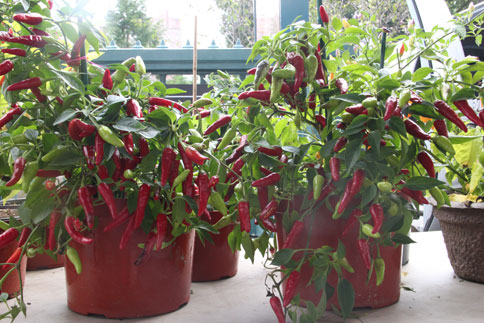
I have been reminded of some tips for helping northern growers increase their tomato production. I think tomato productivity would make a good comment thread topic. A few ideas for the North:
1. Choose the right variety.
2. Warm the soil in advance. Details in the comments.
3. Warm the air and protect from wind.
Here, it's nearing time to add mulch to keep the soil from getting too hot. A woman who won $2000 in a tomato contest in Sacramento (for a single tomato) favors a six-inch layer of straw mixed with shredded newspaper.
Do you have some tomato productivity tips?
Riddles of the Sphinx
On Wednesday morning, I participated in the final walk-through of a new home in our neighborhood. Next door, the neighbors had planted blue and white larkspur in their rose bed in the fall. The blooms had attracted a couple of dozen Striped Morning Sphinx (AKA White Lined Sphinx or Hummingbird) Moths. They are distinctive in flight because of their pink under-wings. Their flight patterns really do resemble those of hummingbirds.
Riddle #1: Why does a garden pest have to be so cute?
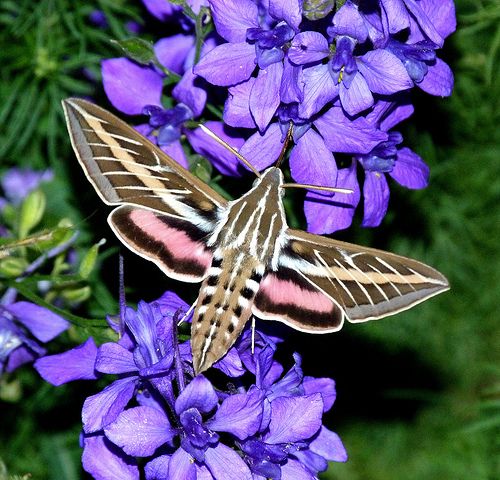
The dominant color of their caterpillars varies from yellow to green to black. They are reportedly edible. I suspect that their edibility may be affected by the plants upon which they have been feeding.
Riddle #2: Why do these caterpillars sometimes migrate en masse across desert highways? "Hundreds of thousands of caterpillars -- a long green mile of them -- are on the crawl in the Dove Mountain community in Marana. "
Several of their host plants are growing in our garden, including apple, evening primrose, grape, purslane and tomato. Guess I should be ready with the Bt spray in a few days, after the moths lay eggs on our tomato plants.
These moths are generally smaller than their cousins, the Tomato Hornworm (Five-spotted Hawkmoth) and Tobacco Hornworm (Goliath Worm) moths. The Tobacco Hornworm is more than just a garden pest:
The tobacco hornworm is sometimes kept as a pet by children throughout its range. It can be distinguished by its seven diagonal lines on its sides; tomato hornworms have eight V-shaped markings. A mnemonic to remember the markings is tobacco hornworms have straight white lines like cigarettes, while tomato hornworms have V-shaped markings (as in "vine-ripened" tomatoes). M. sexta has mechanisms for selectively sequestering and secreting the neurotoxin nicotine present in tobacco.
M. sexta is a common model organism especially in neurobiology, due to its easily accessible nervous system and short life cycle. It is used in a variety of biomedical and biological scientific experiments. It can be easily raised on a wheat-germ-based diet. . .
When fed wheat germ, the caterpillars are turquoise. In the garden, they are hard to spot on tomato plants due to their green color, though they can be detected with UV light at night.
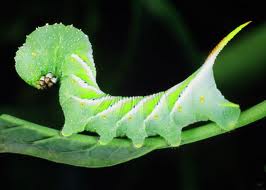
Riddle #4: Which moth became a celebrity in "The Silence of the Lambs?"
There is an answer to this riddle, but it is a little complicated. It was supposed to be a Death's Head Moth, which lives in Europe and Africa. The caterpillars eat potato plants and the adults invade beehives. They squeak and can stab you with their short proboscis. Nice.
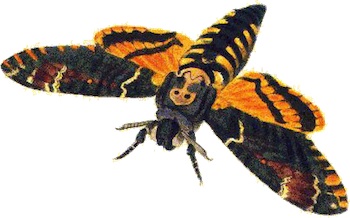
However, according to a film trivia website, tobacco hornworm moths were used in the film. They were treated like celebrities by the filmmakers: "They were flown first class to the set (in a special carrier), and had special living quarters (rooms with controlled humidity and heat)."
The movie posters featured Jodi Foster with a tobacco hornworm moth photo-shopped with a skeleton skull. A really creepy skeleton skull originally featured in a photo with Salvador Dali. It is an unpleasant image, therefore popular for tattoos. I prefer the third photo here.
The cocoons used in the movie were of the Black Witch Moth, the largest moth in North America. They are migratory, one-way. Why? It is a riddle. The caterpillars eat legumes. Bet they could do some serious damage to a pole bean. Depending on which folklore you believe, this moth brings either good luck or bad luck. If you want to attract one to help you win the lottery, put out some fermented fruit or stale beer.
As long as we're setting out fruit for moths, some of us might want to set out some fruit or nectar for Baltimore Orioles escaping the city.
Riddle #5: Which Sphinx Moth is used for fishing?
I will answer this one, too. It is the Catalpa Sphinx, which lives in much of the Eastern United States. The caterpillars, which are semi-gregarious, are so popular for fish bait that there are Catalpa trees maintained as shrubs on worm farms as food for the caterpillars. You can preserve them in your refrigerator. If they are frozen, they may re-animate when thawed. They are a real pest on Catalpa trees, though. Sevin is mentioned as a control but the biological controls (Bt, Tanglefoot and/or parasitic wasps) make more sense to me for this kind of tree.
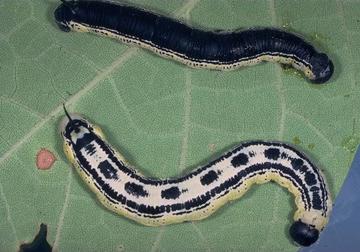
Catalpa, Chitalpa and Desert Willow Trees
The two most commonly planted species of Catalpa in the USA are the Northern (AKA Western) and Southern Catalpa, both natives. Where the Catalpa Sphinx Moth does not live, they are easier to maintain as stately, picturesque trees with showy flowers and big, tropical-looking leaves. Slideshow here. http://www.arborday.org/trees/treeguide/TreeDetail.cfm?ItemID=805
The Northern Catalpa can be invasive. "The brittle wood is rot resistant and was once commercially important as railroad ties, posts, packaging, etc." Because the Catalpa Sphinx Moth doesn't live there and because limited water makes it less invasive, it has been planted in the Western states. The seedpods and twigs can still be messy. The big leaves need protection from wind.

Although they are grown in the Southeast to feed caterpillars for fish bait, the Southern Catalpa is grown more often as a specimen tree in other countries, presumably where big caterpillars do not threaten the leaves.

The Chitalpa is a medium-sized tree, a cross between trees from two related genera: the Southern Catalpa and Chilopsis linearis, the Desert Willow. It does not form seeds. It is quite hardy. The white-flowered one may be better where springs are humid than the pink-flowered one. The City of Los Angeles recommends it as a street tree, in cutouts as narrow as 3 feet. The flowers can be messy, but are not a slipping hazard for pedestrians.
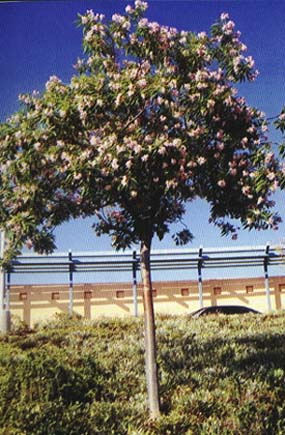
Desert Willow is a graceful tree, widely used in desert landscaping. It attracts orioles, hummingbirds and carpenter bees. The orchid-like flowers are fragrant. It is easily grown from seed, and nurseries select for the best flower forms. It will bloom in a gallon pot, so you can choose the flowers you like best. The seedpods look messy in winter and can spread seedlings, though the trees can be kept short so the seedpods can be trimmed off.
The Santa Fe Botanical Garden features Art's Seedless Desert Willow. I have been to the nursery established by the originator of this cultivar, Art Combe, in the little town of Uintah, Utah. I have driven on Combe Road. But I had no idea that he was called the "Wizard of the Wasatch". He "earned the nickname for his development of over 100 new plant varieties and his reputation for plant husbandry". Valley Nursery is still a great place to buy plants, I hear. I suspect that Art's Seedless Desert Willow is right on the edge of its hardiness range in Uintah. There are a few other seedless cultivars.

A final thought on flowering trees from the Arizona Community Tree Council: The best time to plant a tree was 20 years ago. The second-best time is NOW!
Weirddave's Epiphany
I'm sorry, I can no longer contribute to the horrors that you people perpetrate. Just the other day I was walking alongside the rows of my garden when a shovel fell and hit me on the head (How did it fall, I swear it had been thrust into the dirt beside the broccoli....). I fell to the ground, stunned, and while I was there I heard the singing of angels. Like Saul on the road to Damascus, Their glorious harmonies revealed to me the sinful reality of my old life:
Listen up brothers and sisters,
come hear my desperate tale.
I speak of our friends of nature,
trapped in the dirt like a jail.
Vegetables live in oppression,
served on our tables each night.
This killing of veggies is madness,
I say we take up the fight.
Salads are only for murderers,
coleslaw's a fascist regime.
Don't think that they don't have feelings,
just cause a radish can't scream.
Chorus:
I've heard the screams of the vegetables (scream, scream, scream)
Watching their skins being peeled (having their insides revealed)
Grated and steamed with no mercy (burning off calories)
How do you think that feels (bet it hurts really bad)
Carrot juice constitutes murder (and that's a real crime)
Greenhouses prisons for slaves (let my vegetables go)
It's time to stop all this gardening (it's dirty as hell)
Let's call a spade a spade (is a spade is a spade is a spade)
I saw a man eating celery,
so I beat him black and blue.
If he ever touches a sprout again,
I'll bite him clean in two.
I'm a political prisoner,
trapped in a windowless cage.
Cause I stopped the slaughter of turnips
by killing five men in a rage
I told the judge when he sentenced me,
This is my finest hour,
I'd kill those farmers again
just to save one more cauliflower
Chorus
How low as people do we dare to stoop,
Making young broccolis bleed in the soup?
Untie your beans, uncage your tomatoes
Let potted plants free, don't mash that potato!
I've heard the screams of the vegetables (scream, scream, scream)
Watching their skins being peeled (fates in the stirfry are sealed)
Grated and steamed with no mercy (you fat gormet slob)
How do you think that feels? (leave them out in the field)
Carrot juice constitutes murder (V8's genocide)
Greenhouses prisons for slaves (yes, your composts are graves)
It's time to stop all this gardening (take up macrame)
Let's call a spade a spade (is a spade, is a spade, is a spade, is a spade.....
I can no longer contribute to an endeavor as cruel and evil as this "garden thread" now that the truth has been revealed. I'm going over here to slaughter some cattle with a pocketknife and to wring a chicken's neck, I'm hungry. Good day everyone!
Y-not: That's it for this week. What's happening in YOUR gardens?
m: "Send in the Minnesota National Guard? ..."
Yoda: "[i]Don’t threaten, Mr. President. Do.[/i] ..."
18-1: "[i]I'd rather we smash Minnesota and California./i ..."
Diabeetus: "Once we take out the Mad Mullahs, all sights shoul ..."
El Mariachi - Attorney at Law: "Easy answer to this problem: Stop all federal f ..."
Cow Demon: "It’s 1983 all over again. The Pershing 2s a ..."
man: "sort of MAGA-on-steroids figure, will emerge to ch ..."
Sock Monkey * sporting my Andrew Breitbart attitude : "Hide your lighter fluid, take a deep breath" So ..."
RebeccaH : "*** Trump Threatens to Declare Minnesota to be in ..."
Axeman: "Jeez, guys. It’s been a great 11 months, wit ..."
night lifted: "I hope he is correct. Posted by: Sharon(willow's ..."
After Night of Riots and Attacks on Federal Agents, Trump Threatens to Declare Minnesota to be in a State of Insurrection
The Morning Rant: This Is What We Voted For!
Mid-Morning Art Thread
The Morning Report — 1/15/26
Daily Tech News 15 January 2026
Wednesday Overnight Open Thread - January 14, 2026 [TRex]
Rhino Field Goal Cafe
Quick Hits
Trump Stops the Issuance of Visas to Migrants from 75 Welfare-Sucking Countries
Paul Anka Haiku Contest Announcement
Integrity SAT's: Entrance Exam for Paul Anka's Band
AllahPundit's Paul Anka 45's Collection
AnkaPundit: Paul Anka Takes Over the Site for a Weekend (Continues through to Monday's postings)
George Bush Slices Don Rumsfeld Like an F*ckin' Hammer
Democratic Forays into Erotica
New Shows On Gore's DNC/MTV Network
Nicknames for Potatoes, By People Who Really Hate Potatoes
Star Wars Euphemisms for Self-Abuse
Signs You're at an Iraqi "Wedding Party"
Signs Your Clown Has Gone Bad
Signs That You, Geroge Michael, Should Probably Just Give It Up
Signs of Hip-Hop Influence on John Kerry
NYT Headlines Spinning Bush's Jobs Boom
Things People Are More Likely to Say Than "Did You Hear What Al Franken Said Yesterday?"
Signs that Paul Krugman Has Lost His Frickin' Mind
All-Time Best NBA Players, According to Senator Robert Byrd
Other Bad Things About the Jews, According to the Koran
Signs That David Letterman Just Doesn't Care Anymore
Examples of Bob Kerrey's Insufferable Racial Jackassery
Signs Andy Rooney Is Going Senile
Other Judgments Dick Clarke Made About Condi Rice Based on Her Appearance
Collective Names for Groups of People
John Kerry's Other Vietnam Super-Pets
Cool Things About the XM8 Assault Rifle
Media-Approved Facts About the Democrat Spy
Changes to Make Christianity More "Inclusive"
Secret John Kerry Senatorial Accomplishments
John Edwards Campaign Excuses
John Kerry Pick-Up Lines
Changes Liberal Senator George Michell Will Make at Disney
Torments in Dog-Hell
The Ace of Spades HQ Sex-for-Money Skankathon
A D&D Guide to the Democratic Candidates
Margaret Cho: Just Not Funny
More Margaret Cho Abuse
Margaret Cho: Still Not Funny
Iraqi Prisoner Claims He Was Raped... By Woman
Wonkette Announces "Morning Zoo" Format
John Kerry's "Plan" Causes Surrender of Moqtada al-Sadr's Militia
World Muslim Leaders Apologize for Nick Berg's Beheading
Michael Moore Goes on Lunchtime Manhattan Death-Spree
Milestone: Oliver Willis Posts 400th "Fake News Article" Referencing Britney Spears
Liberal Economists Rue a "New Decade of Greed"
Artificial Insouciance: Maureen Dowd's Word Processor Revolts Against Her Numbing Imbecility
Intelligence Officials Eye Blogs for Tips
They Done Found Us Out, Cletus: Intrepid Internet Detective Figures Out Our Master Plan
Shock: Josh Marshall Almost Mentions Sarin Discovery in Iraq
Leather-Clad Biker Freaks Terrorize Australian Town
When Clinton Was President, Torture Was Cool
What Wonkette Means When She Explains What Tina Brown Means
Wonkette's Stand-Up Act
Wankette HQ Gay-Rumors Du Jour
Here's What's Bugging Me: Goose and Slider
My Own Micah Wright Style Confession of Dishonesty
Outraged "Conservatives" React to the FMA
An On-Line Impression of Dennis Miller Having Sex with a Kodiak Bear
The Story the Rightwing Media Refuses to Report!
Our Lunch with David "Glengarry Glen Ross" Mamet
The House of Love: Paul Krugman
A Michael Moore Mystery (TM)
The Dowd-O-Matic!
Liberal Consistency and Other Myths
Kepler's Laws of Liberal Media Bias
John Kerry-- The Splunge! Candidate
"Divisive" Politics & "Attacks on Patriotism" (very long)
The Donkey ("The Raven" parody)

